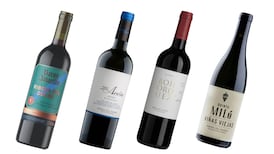All-purpose, versatile, or flexible, call them what you will, but they are probably the most useful style of wines to have on hand, especially during the festive season. These are wines that can be drunk on their own, either before a meal, or if a friend drops in for a chat. But they are also food-friendly, able to partner up with a wide variety of dishes. If you expect to have plenty of people calling around, these are the kind of wines that should be on your shopping list. They also make for very good last-minute presents.
The key with white wines is to avoid anything that is too austere. One glass of something crisp and dry before dinner is fine, but if you are sitting around with friends, you want something that offers a little more fruit and won’t have you reaching for the antacid tablets. The two best-known white wine grape varieties, Sauvignon Blanc and Chardonnay, fit very neatly into this category. Sauvignon goes well with a variety of foods, especially those with herbs or spices. The better New Zealand versions tend to be the most aromatic, with lively lime zest and kiwi fruits; South African Sauvignon Blanc often has a similar taste profile, whilst Chile is a little rounder and fruitier. These three are probably the most flexible, although a glass of good Touraine Sauvignon from the Loire valley can also have enough fruit to counter the vibrant acidity of this variety.
Chardonnay is much maligned, but the unoaked versions are probably the most versatile wine of all; vibrant and fruity, they are easy to drink on their own, but go with a a range of dishes, meat as well as fish. You could even think about drinking it with your Christmas turkey. Less widely available, but worth seeking out, are Grüner Veltliner from Austria and Alvariño from Spain. These generally fall into that medium-bodied fruity category that covers all bases.
When choosing reds, it is important to avoid those that are too powerful or too tannic. This rules out most Cabernet Sauvignons (Bordeaux in particular), as well as Australian Shiraz, Pinotage, Zinfandel, Carmenère and big Grenache-based wines. All of these may be perfect with a warming winter stew or a big roast, but will be difficult to drink on their own. I would also exclude very oaky wines, which means no Rioja Reserva and Gran Reserva. In terms of alcohol, 13-13.5 per cent is ideal; anything more can be overpowering. There are a few very attractive light wines with levels of 12.5 per cent. Look out for wines made from Merlot, lighter Grenache-based wines, as well as Pinot Noir and Gamay. Merlot has become unfashionable of late, largely due to the 2004 movie Sideways, where the lead character, Miles, memorably says: "If anyone orders Merlot, I'm leaving. I am not drinking f***ing Merlot."
Despite this, Merlot is in many ways the perfect all-purpose wine, soft with gentle plum fruits, and without any drying tannins. The cheaper versions tend to be unoaked, and therefore perfect without food. Merlot from Chile, provided it has reasonable alcohol levels, can be both inexpensive and pleasantly fruity. The south of France is another potential source.
Pinot Noir is one the most versatile wines of all. Soft and silky, with light fruits and no tannins, it can be happily drunk on its own. It also goes well with fish such as salmon and tuna, as well as all kinds of red and white meats. However, anything from Burgundy (the home of Pinot Noir) tends to be prohibitively expensive, for a causal wine at least. Instead look to Chile, the south of France and New Zealand for more affordable versions. Just south of Burgundy lies Beaujolais, the home of the Gamay grape.
For very different reasons to Merlot, the wines of Beaujolais have also become less attractive to many. But I would certainly rate these amongst my favourite flexible wines.
Even Beaujolais Nouveau, unknown to the younger generation, can be very good these days, and has just made its annual appearance in a few wine shops. Terroirs in Donnybrook may still have a few bottles of their excellent Nouveau available.
I have discussed medium-bodied Spanish reds here before. Unoaked Rioja and other Tempranillo work very well as all-purpose wines. Lastly, in recent weeks I have enjoyed a few very tasty medium-bodied red wines from Italy that fit perfectly into this category.
l John Wilson's Wilson on Wine 2015, published by Irish Times Books, is in bookshops now, priced €12.99











